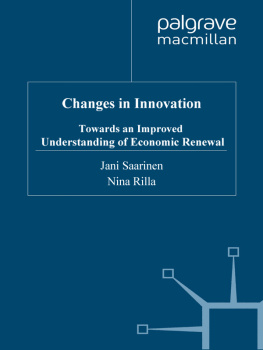Chris Duffey - Superhuman Innovation
Here you can read online Chris Duffey - Superhuman Innovation full text of the book (entire story) in english for free. Download pdf and epub, get meaning, cover and reviews about this ebook. year: 2019, publisher: Kogan Page, genre: Business. Description of the work, (preface) as well as reviews are available. Best literature library LitArk.com created for fans of good reading and offers a wide selection of genres:
Romance novel
Science fiction
Adventure
Detective
Science
History
Home and family
Prose
Art
Politics
Computer
Non-fiction
Religion
Business
Children
Humor
Choose a favorite category and find really read worthwhile books. Enjoy immersion in the world of imagination, feel the emotions of the characters or learn something new for yourself, make an fascinating discovery.
- Book:Superhuman Innovation
- Author:
- Publisher:Kogan Page
- Genre:
- Year:2019
- Rating:5 / 5
- Favourites:Add to favourites
- Your mark:
- 100
- 1
- 2
- 3
- 4
- 5
Superhuman Innovation: summary, description and annotation
We offer to read an annotation, description, summary or preface (depends on what the author of the book "Superhuman Innovation" wrote himself). If you haven't found the necessary information about the book — write in the comments, we will try to find it.
Superhuman Innovation — read online for free the complete book (whole text) full work
Below is the text of the book, divided by pages. System saving the place of the last page read, allows you to conveniently read the book "Superhuman Innovation" online for free, without having to search again every time where you left off. Put a bookmark, and you can go to the page where you finished reading at any time.
Font size:
Interval:
Bookmark:

Transforming business with artificial intelligence
Chris Duffey

Publishers note
Every possible effort has been made to ensure that the information contained in this book is accurate at the time of going to press, and the publisher and author cannot accept responsibility for any errors or omissions, however caused. No responsibility for loss or damage occasioned to any person acting, or refraining from action, as a result of the material in this publication can be accepted by the editor, the publisher or the author.
First published in Great Britain and the United States in 2019 by Kogan Page Limited
Apart from any fair dealing for the purposes of research or private study, or criticism or review, as permitted under the Copyright, Designs and Patents Act 1988, this publication may only be reproduced, stored or transmitted, in any form or by any means, with the prior permission in writing of the publishers, or in the case of reprographic reproduction in accordance with the terms and licences issued by the CLA. Enquiries concerning reproduction outside these terms should be sent to the publishers at the undermentioned addresses:
2nd Floor, 45 Gee Street
London
EC1V 3RS
United Kingdom
122 W 27th St, 10th Floor
New York, NY 10001
USA
4737/23 Ansari Road
Daryaganj
New Delhi 110002
India
Chris Duffey 2019
The right of Chris Duffey to be identified as the author of this work has been asserted by him in accordance with the Copyright, Designs and Patents Act 1988.
Chart design by Connor Delaney
Chapter opening graphics from Adobe Stock
ISBNs
Hardback 978 0 7494 9804 7
Paperback 978 0 7494 8383 8
eBook 978 0 7494 8384 5
Typeset by Integra Software Services, Pondicherry
Print production managed by Jellyfish
Printed and bound in Great Britain by CPI Group (UK) Ltd, Croydon CR0 4YY
To my parents, who instilled in me the love of life-long learning
To my wife and two daughters, who are my constant inspiration
To my sister, who showed me what honest success looks like
Chris Duffey spearheads Adobes Creative Cloud strategic development innovation partnerships across the creative enterprise space.
Chris and his work have been profiled by The Wall Street Journal, The Guardian, Inc., Adweek, Adage, Cheddar, The Mirror, The Drum, Campaign, CMO.com, NYPost, Business Insider, and have been featured by Google, McKinsey and Wharton in their digital marketing book. Chris also serves on Rutgers University Data Advisory Board and the Board of Directors for ANA NY.
Prior to Adobe Chris was an award-winning executive creative director, speaker, author and AI and mobile technologist. Business Insider named him as one of the industrys leaders on the top issues, challenges and opportunities in the fast-changing world of mobile marketing. He has been a creative consultant with 35 advertising agencies across all the major global holding companies: WPP, IPG, Havas, Omnicom, Publicis and MDC, and has worked across every major industry vertical. Chris is an accomplished author on the inevitable relevance of AI and mobile, with an affinity towards creating innovation for the most complex business challenges imaginable. The Guardian listed How mobile became mighty in healthcare, an article he co-wrote, in their top ten best healthcare stories of the year.
Chriss keynotes have received more than 50 million impressions. His sessions have been reported around the world by Access Hollywood, Extra, OK magazine, Hello, People, the Daily Mail, NYPost, Adweek and The Drum.
Throughout my career as a creative director and creative technologist, I have always been fascinated when human creativity and ingenuity meet and is then amplified by technology. We will explore in great depth in the upcoming pages how, over the past number of years, artificial intelligence has become one of the greatest technical advances. I wanted to celebrate the capabilities and possibilities of AI, but also to test its limits, not only by writing a book about it but actually using AI to help write it. Capturing AIs current and future abilities has been a journey of exploration which has led to a number of exciting discoveries. But there were also times when it became clear that in some instances AI was just not there yet. So, in the hope of showing how transformational AI can be, I assembled some AI technologies to become a co-author. What follows is an overview of my approach. Much like the writing process, my use of AI was organic and non-linear and often deployed a layering of different techniques.
In the early to mid-2000s we were in a similar new era of mobile. Clients often asked us to describe how a mobile responsive website or app was built. Before answering, the first thing was always to decide how many technical layers to peel back: what went into the visual design process, which UX tools were used, an explanation of software development codes, how to use iPhone or Android hardware capabilities and components such as chips, geolocation abilities. The list went on and on. Most recently this was done through full-day tech sessions with the introduction of the Apple Watch and health kit and Amazon Alexa. And, as in the early days of mobile and wearables, we are going through a similar conversation with the technical building blocks of AI. This lays the AI foundation for strategic and creative discussions on how, when and where to make best use of the technology.
Rather than starting out with how is it built or trying to use a specific AI technique, my general approach in using AI as a co-creation tool for this book was to begin with a fundamental question: what can this specific AI function do and how can it help? With this focus I used a number of AI APIs (application program interfaces) while writing. Although they made for a lengthy list, it included everything from using AI to compose responses on specified topics, the suggestion and prediction of contextual content that might be relevant, translation of multi-language reference materials and then summarization, sentence analysis and separation, constituency parsing to determine sentence structure and meaning, tone analyser to understand emotions and communication style in the text review stage, sentiment analysis to analyse and generate a summary of insights, characteristics and values inherent to the text. In the context of this book, the AI function or Aim is not a single sourced technology but rather a suite of technologies, many of which are open-source, each building on a different set of concepts, approaches and infrastructures. The conversational agent leverages a number of expert systems using AI and ML techniques such as natural language processing (NLP), natural language understanding (NLU) and natural language generation (NLG) APIs. These techniques for example allow Aim to identify, understand and respond to key words, phrases, ideas and requests, and at times instances of recognition and understanding of experiences and reasoning.
The underlying aspects of the AI used in Superhuman Innovation primarily embody three systems: AI voice recognition, AI content understanding and summarization, AI content creation and generation. Voice recognition and continuous dictation enables human-to-system interaction through a voice-user interface (VUI) for tasks such as speech-to-text, text-to-speech, voice editing, formatting, spelling, and sharing documents. AI content understanding and summarization technology reviews and abridges databases, articles or research papers into quick digestible content through approaches such as sentiment analysis, labelling and the organization of higher-level concepts based on contextual understanding. AI content creation and generation is the ability of the system to develop concepts and ideas to aid the content creation process. Writing algorithms to emulating the human writing process helped contribute ideas, titles, content and drafts.
Font size:
Interval:
Bookmark:
Similar books «Superhuman Innovation»
Look at similar books to Superhuman Innovation. We have selected literature similar in name and meaning in the hope of providing readers with more options to find new, interesting, not yet read works.
Discussion, reviews of the book Superhuman Innovation and just readers' own opinions. Leave your comments, write what you think about the work, its meaning or the main characters. Specify what exactly you liked and what you didn't like, and why you think so.










